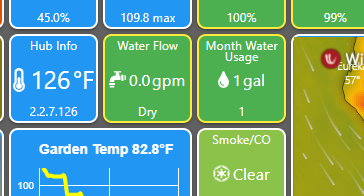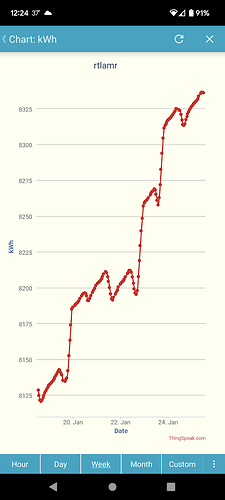I don't know of anything like this for gas. That would be nice though.
Just installed the Flume-2 and using @tomw driver. Easy install, no issues. Got it up on HE dashboard and Sharptools dash. Set a notification in HE if "wet" for more than 1 hour.

Late to the party here. I gather I could use the Flume 2 to detect leaks from unusual water flow, use water/moisture sensors to detect actual water from a leak, and then use the Zooz Titan Water Valve Actuator ZAC36 or the Dome product to turn the water off if either the Flume 2 or the leak sensors detected a leak. Right? Is that what people here are doing with the Flume 2?
Yes that is exactly what I am doing. Except I have the Flume 2 + bulldog valve but same process basically. Also am adding in some Linkind sensors I just picked up.
Note: I also have some leak sensor that will NOT trigger the water main shutoff. Here in NJ, US our water table is very high + we get a fair amount of rain so wet basements are not all that uncommon especially in older houses like mine.
Way off topic here...but....I can't contain my trigger here....
This brings back memories...many years back....in a place far far away....where the plastic _luidmaster standpipe in the upstairs toilet sheared off and the valve free flowed beyond the capacity of the in-tank drain....flooding the UPSTAIRS bathroom and below, for hours, while we were off shopping.
Upon close inspection you could see the failure right at the little tabs that kept that standpipe attached to the flange that screws through the toilet tank.
The valve company stood up to the insurance company saying WE MUST have put chlorine tablets in the tank (which we never did) because clearly on the box it warns against this.
"No...we didn't"....and besides I asked, "why in this day and age aren't you using chlorine resilient plastics"? The reply...."customers wouldn't pay the premium". HUH????? I said...."are you kidding me, knowing their toilets are disasters waiting to happen due to chlorine breakdown of your plastic product??? IT WOULD BE A MARKETING ANGLE DUDE" (actually, I think Dell was using 'dude' a lot back then).
OK, the consequences were significant...and as a result I went about taking every _luidmaster toilet valve out of the house. Guess what I found! Hairline fractures in every single one of those little tabs that attached the standpipe to the flange. Chemical breakdown or product quality you decide. Time bombs !!!!
So here is the gotcha.... I called the company contact back after discovering this and I asked...does this happen a lot across the country? He said, well, and I quote...""""more in some cities than in others"""". I said, "OH, ( YOU SOB I THOUGHT TO MYSELF) you mean like in places and parts of the country where the municipal water systems tend to put a tad bit more chlorination in their water supplies!!!! He paused, and said something like....well....I donno.
You'd think the insurance companies would have been onto this.
Know what you can find in the stores now....toilet valves that EXPLICITLY SAY they are built to contend with chlorine! First saw it in competitive products. Meanwhile _luidmaster gets away with years of malfeasance... and the big boxes continued to keep them on the shelves.
So,...that's what chlorine tablets in toilet tanks triggers in me ![]()
Sorry, we now return you to your regularly scheduled program.
P.S. Ironically when we first moved to the subject city and filled up the bath tub I swear it smelled like swimming pool water to me. So yeah, some systems put A LOT of chlorine in their water to contend with issues in their infrastructure and their climate conditions.
This is literally the reason I have a 48 port pex manifold.
I'd like to keep flow detection local and zigbee. I happened across a Sinope Flow Sensor that is an accessory for their water valve. Anybody used this?
Follow me for more plumbing tips!
Old thread, I know. But I'm tracking my water and gas usage with a RTL dongle. Both my water and gas meters broadcast usage for the companies to read. Depending on the meters, you can read them too.
If you want to go down that rabbit hole, look up RTL-SDR radios and RTLAMR. I run this on a raspberry pi and send the data over to influxdb.
I've run RTLAMR to read my electric meter for 5 years now, ever since I installed solar PV. Really easy to set up.
(Of course, you have to go out of your way to not read your neighbor's meters; e.g., you can determine when they are away when their power usage drops. I pick up about 12 electric meters, and we are in an area with a wide spacing between houses).
I've never succeeded in reading my gas or water meters, both of which I should be able to read.
Well this is an interesting concept. I can/will do some googling on it, but to save some time, do either of you happen to have some good resources/guides to read about how to do this? Not sure how many RLT dongles might exist out there (this isn’t something I’ve looked into before).
rtlamr is the software package that reads meters, decoding the protocols (SCM, SCM+, IDM, R900, etc) that the meters broadcast. It pretty much has all the information needed to set this up. It's written in Go, and you can compile it yourself or download binaries.
The Wiki has a page with known-to-work meters: https://github.com/bemasher/rtlamr/wiki/Compatible-Meters
There is a forum for help/questions: Disqus - README
rtlamr uses the library from the RTL-SDR project. Their about page has lots of links to related information:
https://www.rtl-sdr.com/about-rtl-sdr/
You will need any dongle that says it works with RTL-SDR. Searching "RTL-SDR" on Amazon will find many of them.
6 years ago I got this one (https://www.amazon.com/gp/product/B00D3GRU24) for $14. It's no longer available, but ones just like it will show up in the above search.
These days, it seems a popular dongle is the Nooelec NESDR Nano 2. $24
Thanks for the info! I appreciate it
You hit all the points here.
Basically you need to run rtl_tcp first and leave it running, then rtlamr connects to it.
Here is my little script I run to poll my meters. For each meter I let it listen for 5 minutes. I then run this script every 15 minutes from crontab. There's probably a better way to do this, but it's what I came up with and has been working for years. I use curl to post the results to a influx database, then visualize it later with grafana.
Once you get to playing around with Influx and Grafana there is a app called InfluxDBLogger that will log whatever hubitat parameters too. Then you can visualize just about anything from your hub. Power usage, temps, switches, motion, etc.
I have all this running on a raspberry pi. They're a little hard to come by currently, but any old computer could do it too.
I originally was going to do something similar, but I ended up with a different approach.
I just leave rtlamr and rtl_tcp running all the time. Back in 2015 I contributed some code to rtlamr to make this easier. I basically use rtlamr with -unique and -filterid to just listen for my meter(s) and write all the values to a file. I push the latest value for my electric meter via curl to ThingSpeak(*) once every half hour to keep an ongoing chart.
My whole setup was originally on a FreeBSD machine, but then for some silly reason I moved it to a Windows machine. (both of which are in-house servers and always on anyway)
(*) ThingSpeak is slightly weird, but it is free and is owned by the company I retired from. Sadly, when I retired I lost access to MATLAB.
Hats off to you guys for getting this running and the folks that figured it out on the back end. Been wanting to do this since the early implementations of Itron's radio meters but figured it would take their kit to come up with a solution. Never dreamed this would all be out in the open. That's both good, AND BAD !
Yes. There are so many things I can see in this image, which is my meter report from the last week. The steep up slopes are when the car was plugged in and charging. The steep down slopes are the solar PV generating during the daytime. Today there is still very little generation because we had 1" of snow overnight and the sun is still melting it off (the upper bank of panels dump their snow on the lower bank, so half are getting around to generating now that the sun is out). You can even infer where the heat ran by the differences in the slope.
Thanks for this and for your script as well.
I took a look at my electrical and gas meters today and both seem to be compatible, so an order has been put in for the SDR. Looks like I have a new project!
I run a splunk server at home, I currently push some data about my heating system into it from Hubitat, so I’ll more than likely push this data as well, assuming everything works as expected.
Can you filter on two different device types though? I need to use r900 for the water and scm+ for the gas. At least back when I set this up I don't recall being able to listen for both at the same time.
I also forget about my electric meter. I seem to recall it was some propritery or encrypted deal. I use a clamp meter on the main breaker for that..
I don't know. Something I'll have to investigate!
When I looked at your script, I realized that is probably why never saw data for my water or gas meters - I was only ever running with scm (*), so the other meters weren't showing up.
(*) from 2015-2021 my Itron electric meter did scm; when the Powerwalls were being installed, they couldn't open the meter because the electric company had a lock on it; when the electric company came to unlock it, they no longer had the key (!!), so they cut it open and replaced it with a newer one, that does scm+.


